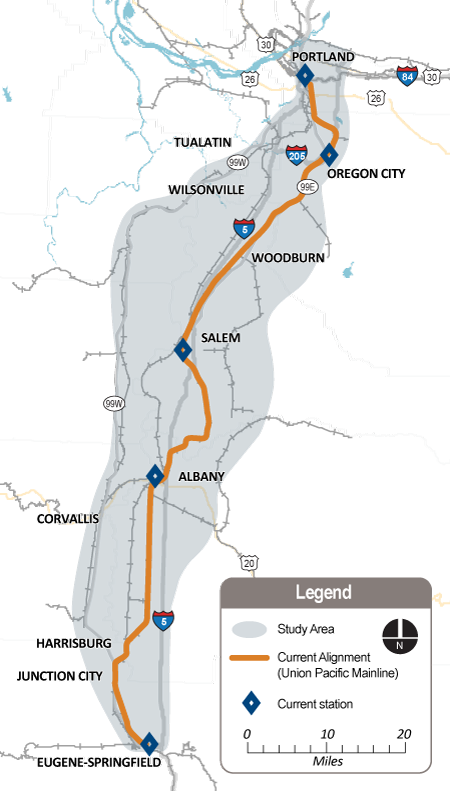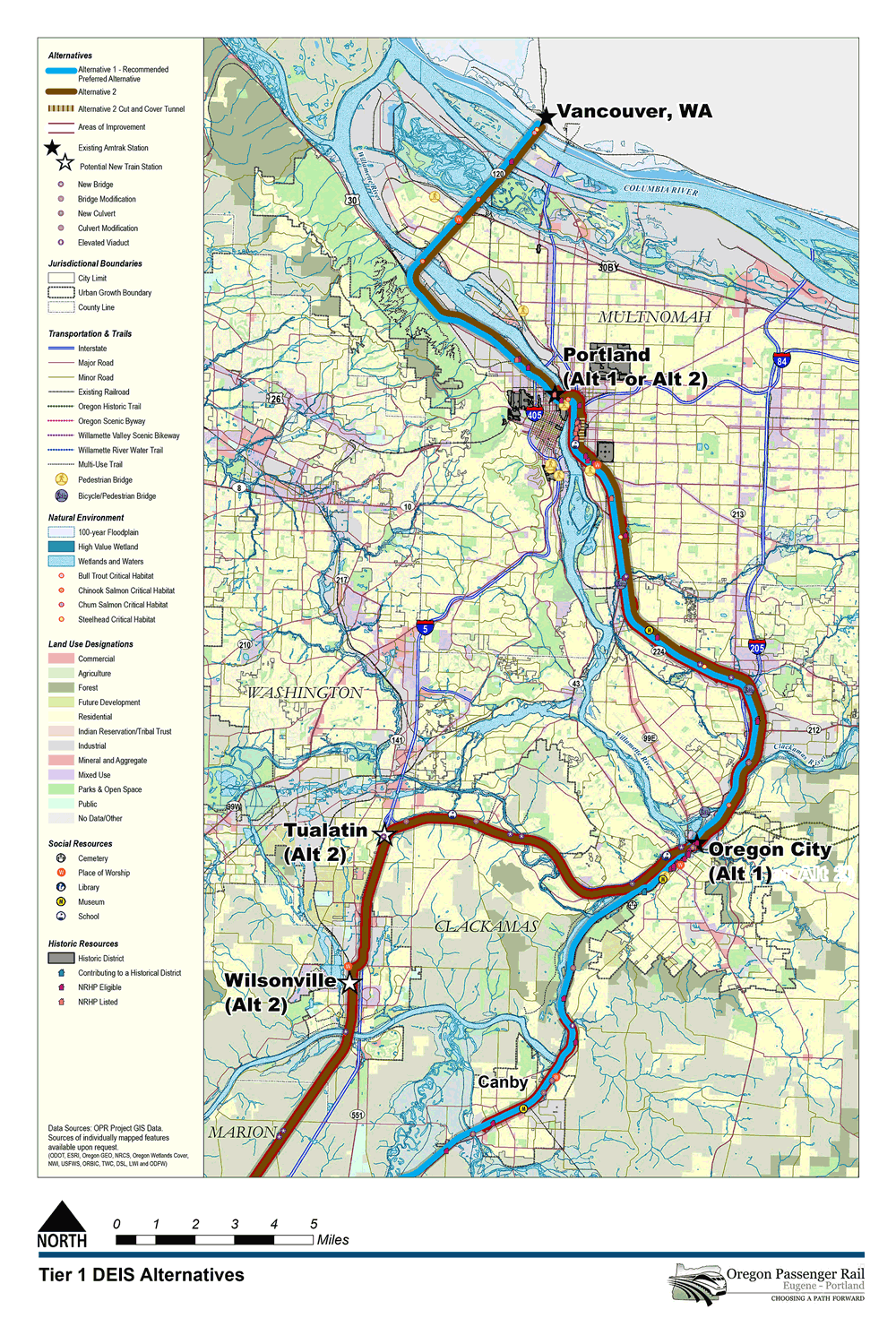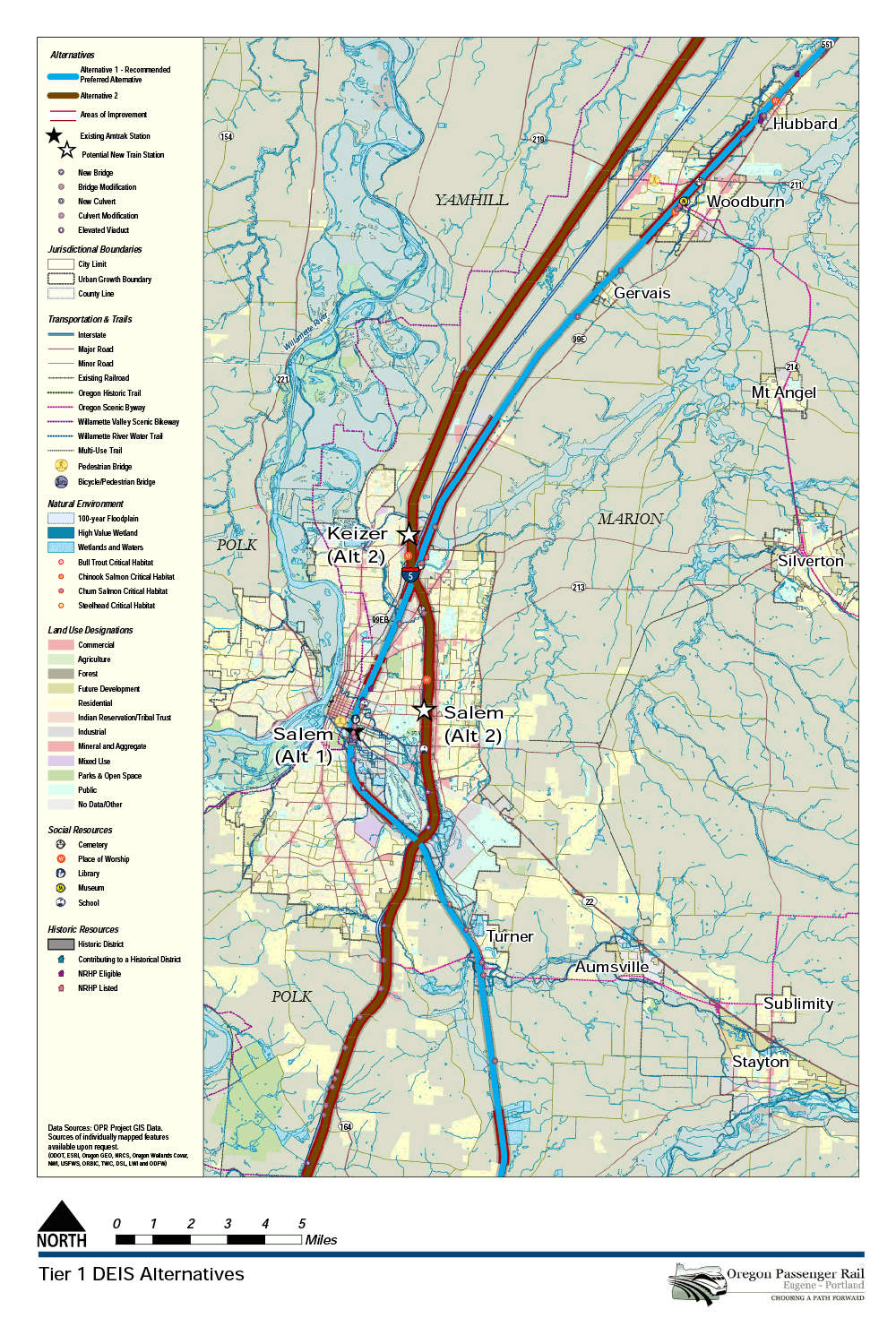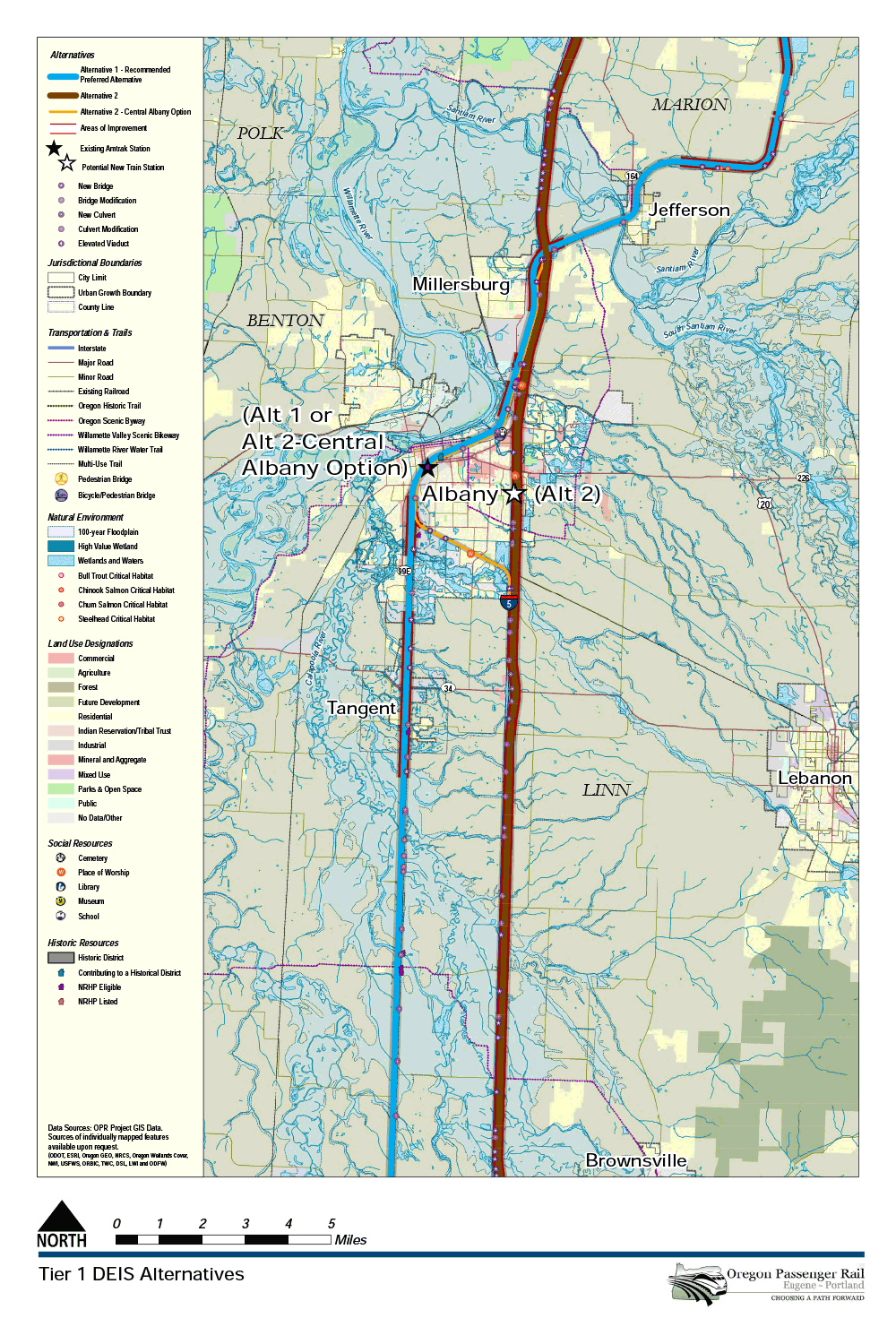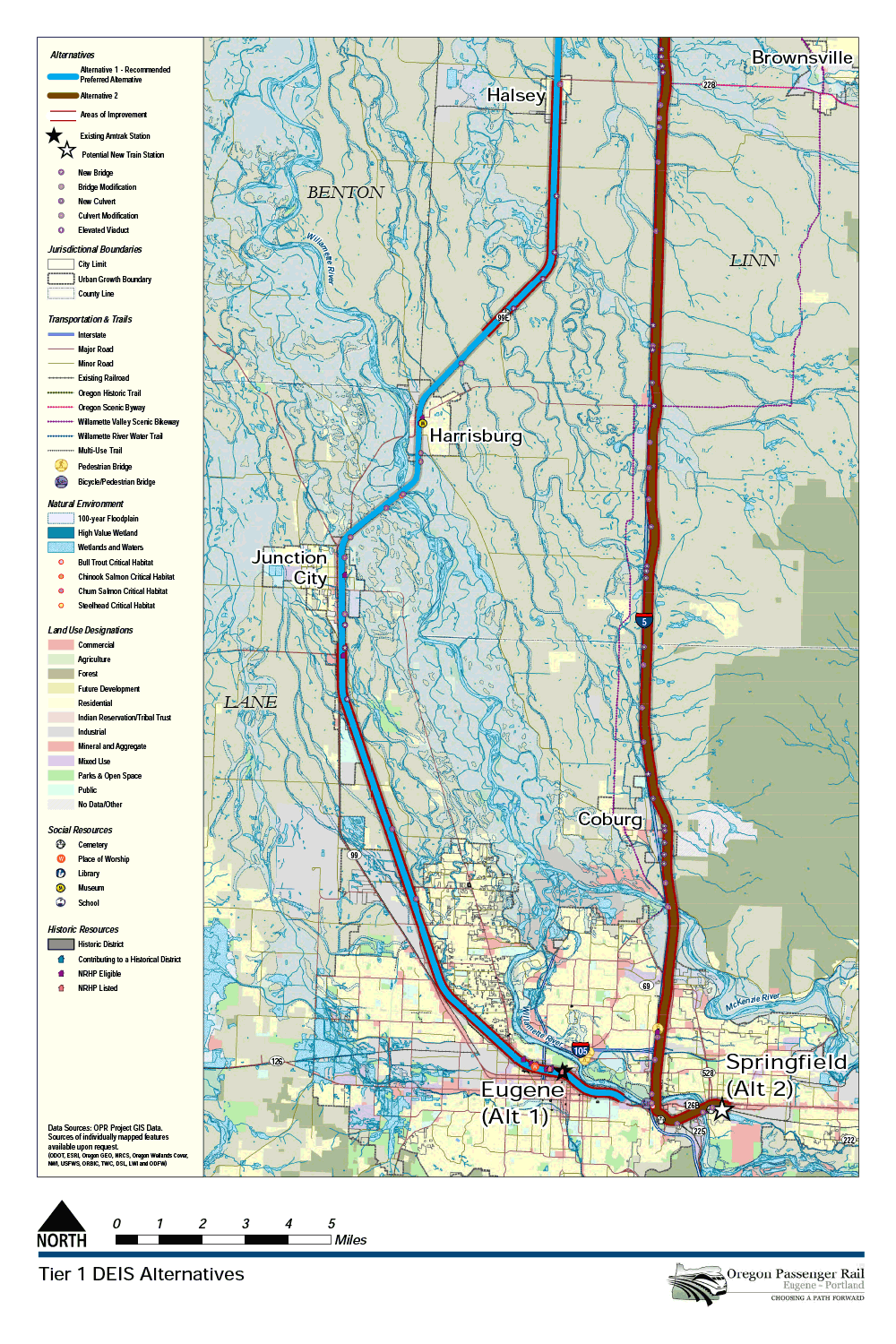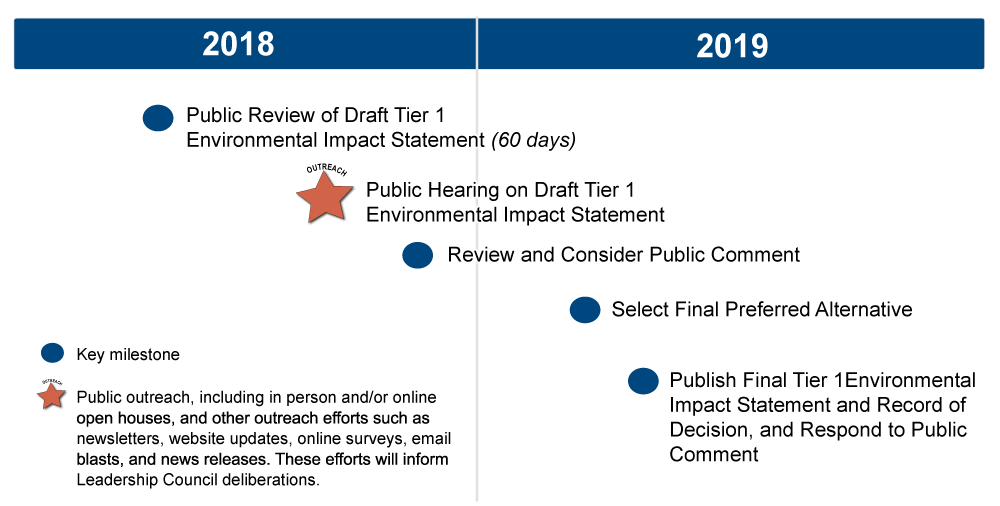Draft Environmental Impact Statement Documents
- DEIS (PDF, 6.6MB)
- Appendices (PDF, 43.5MB).
Select a station below or click "Next" to move through the open house in order.
Stations
The project team is conducting a National Environmental Policy Act environmental review to decide:
- Service characteristics and frequency.
- Rail alignment.
- Technology.
- Station locations.
Oregon Passenger Rail and NEPA
Oregon received a federal grant from the Federal Railroad Administration for the Oregon Passenger Rail study, which means the project is following the National Environmental Policy Act process:
- Analysis and reporting are required for all negative and positive environmental impacts — including cultural, natural and social.
- The public (you!) will be involved to help us make informed decisions.
A Tier 1 Environmental Impact Statement:
- Addresses broad corridor-level issues (rail alignment, service improvements and communities with stations).
- Concludes with a decision on a “Final Preferred Alternative.”
- Requires additional environmental studies before any construction can begin.
Project Purpose
The purpose of the Oregon Passenger Rail project is to improve the frequency, convenience, speed and reliability of passenger rail service along the Oregon segment of the Federally designated Pacific Northwest Rail Corridor in a manner that will:
- Provide riders an efficient, safe, equitable and affordable alternative to highway, bus and air travel.
- Be a cost-effective investment.
- Protect freight-rail carrying capability.
- Support the ongoing implementation of regional high-speed intercity passenger rail between the Eugene-Springfield metropolitan area and Vancouver, British Columbia.
- Be compatible with the Washington State portion of the Pacific Northwest Rail Corridor.
- Promote economic development.
- Avoid or minimize community and environmental impacts.
- Integrate with existing and planned multi-modal transportation networks.
Project Need
Multiple transportation, land use, socioeconomic and environmental considerations drive the need for this project:
- Increasing intercity and regional travel demands.
- Limited rail system capacity and competing service needs.
- Constrained state and local roadway funding.
- Increased economic vitality of the corridor.
- Promoting transportation system safety and security.
- Changing transportation demand resulting from demographic changes.
Read the full Purpose and Need Statement. (pdf)
The Purpose and Need statement is the foundation of the Oregon Passenger Rail project. The statement was developed based on input from the public, stakeholders and the Leadership Council.
Goals and Objectives
The goals and objectives were used as the basis for evaluating the alternatives. Alternatives that better meet goals and objectives score higher in the evaluation.
How alternatives were narrowed
- Develop Purpose and Need, along with goals and objectives.
- Develop an evaluation framework.
- Identify a broad range of corridor concepts.
- Screen corridor concepts against Purpose and Need.
- Evaluate preliminary alternatives using the evaluation criteria (based on goals and objectives).
- Narrow the range of alternatives for further study.
- Publish Draft Tier 1 Environmental Impact Statement. We are here
- Select Preferred Alternative.
- Publish Final Tier 1 Environmental Impact Statement.
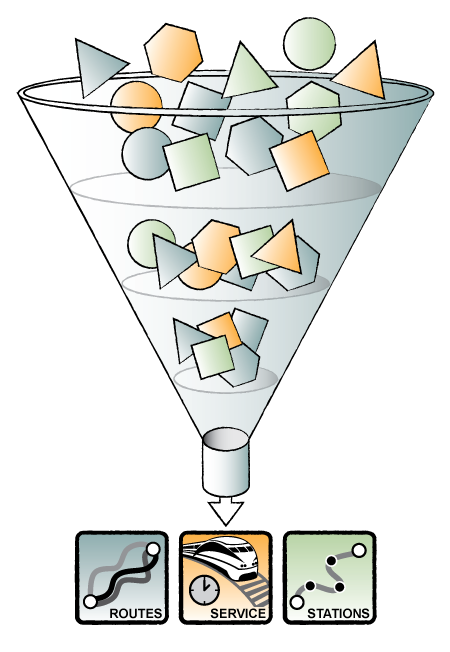
Alternatives
Alternative 1 follows the existing Amtrak Cascades passenger rail route with track, signal and communication improvements.
Alternative 2 is primarily a new route between Springfield and Oregon City along Interstate 5, an existing freight rail line and Interstate 205. It would follow the existing alignment north of Oregon City.
The No Action Alternative follows existing Amtrak route with no additional service or improvements.
Performance Comparisons
- Cost estimates are planning-level construction and engineering estimates and do not include ongoing operations or maintenance costs. Costs are in 2015 dollars.
- Estimated travel times assume stops at five stations (same as existing service). Each additional stop would add time.
- The current scheduled travel time from Portland to Eugene is 2 hours, 35 minutes.
| Criteria | Alternative 1 | Alternative 2 |
| Passenger rail trip time: Eugene to/from Portland | 2 hours, 20 minutes | 2 hours, 2 minutes |
| Ability to accommodate higher speeds in the future | Maintains current maximum speed (79 mph) | Maximum speeds of 120 mph on portions of new alignment |
| Capital costs through 2035 (2015 dollars) | $870 million-$1.025 million | $3.62 billion-$4.44 billion |
| Ridership (2035) | 739,000 | 723,000 |
| Produces benefits and minimizes negative impacts | Higher frequency and ridership; improves service to central cities | Higher frequency and ridership, but service focused outside central cities |
| Support preservation of land, avoid and minimize negative impacts | Lower footprint and construction impacts than Alternative 2 | New alignment, thus higher right-of-way and environmental impacts than Alternative 1 |
Station Activity
| Station | Existing Conditions (2015) |
No-Build Alternative (2035) |
Alternative 1 (2035) |
Alternative 2 (2035) |
| Eugene | 85,800 | 172,500a | 362,300 | - |
| Springfieldb | 85,800 | 172,500c | - | 350,400 |
| Albany | 31,800 | 54,800 | 119,300 | 122,500d |
| Saleme | 65,300 | 97,100 | 203,700 | 203,500 |
| Oregon City | 15,100 | 17,000 | 40,500 | - |
| Willsonvillef | 15,100 | 17,000 | - | 39,800 |
| Portlandg | 458,800 | 961,100 | 1,136,900 | 1,125,500 |
| Total | 656,800 | 1,302,500 | 1,862,700 | 1,841,700 |
a There were no plans to extend the current Portland to Salem bus south to Eugene when the ridership forecasting was done. Therefore numbers for Albany and Eugene do not include a seventh bus round trip.
b Existing conditions and No Action Alternative values represent ridership at the existing Eugene Station. The analysis for Alternative 2 assumed a new station would be located near the potential new Springfield station (an existing transit center).
c There were no plans to extend the current Portland to Salem bus south to Eugene when the ridership forecasting was done. Therefore numbers for Albany and Eugene do not include a seventh daily bus round trip.
d All alternative values represent ridership at the existing Albany Station.
e Existing conditions and No Action Alternative values represent ridership at the existing Salem Station. The analysis for Alternative 2 assumed a new station would be located along 1-5.
f Existing conditions and No Action Alternative values represent ridership at the existing Oregon City Station. The analysis for Alternative 2 assumed a new station would be located at the Wilsonville South Metro Area Regional Transit (SMART) Transit Center.
g Activity at Portland's Union Station encompasses all Amtrak Cascades train and Thruway bus passengers in Portland, including those from north of the Portland market.
Comment on the DEIS
- Submit comments below through Dec. 18
- Mail comments to:
Oregon Passenger Rail - 1110 SE Alder Street, Suite 301
Portland, OR 97214 - Email info@oregonpassengerrail.org.
- Contact ODOT directly:
Jennifer Sellers, ODOT Rail and Public Transit
Jennifer.Sellers@odot.state.or.us, (503) 480-5556
ODOT and the Federal Rail Administration will review all comments and testimony. Responses will appear in the final Environmental Impact Statement.





